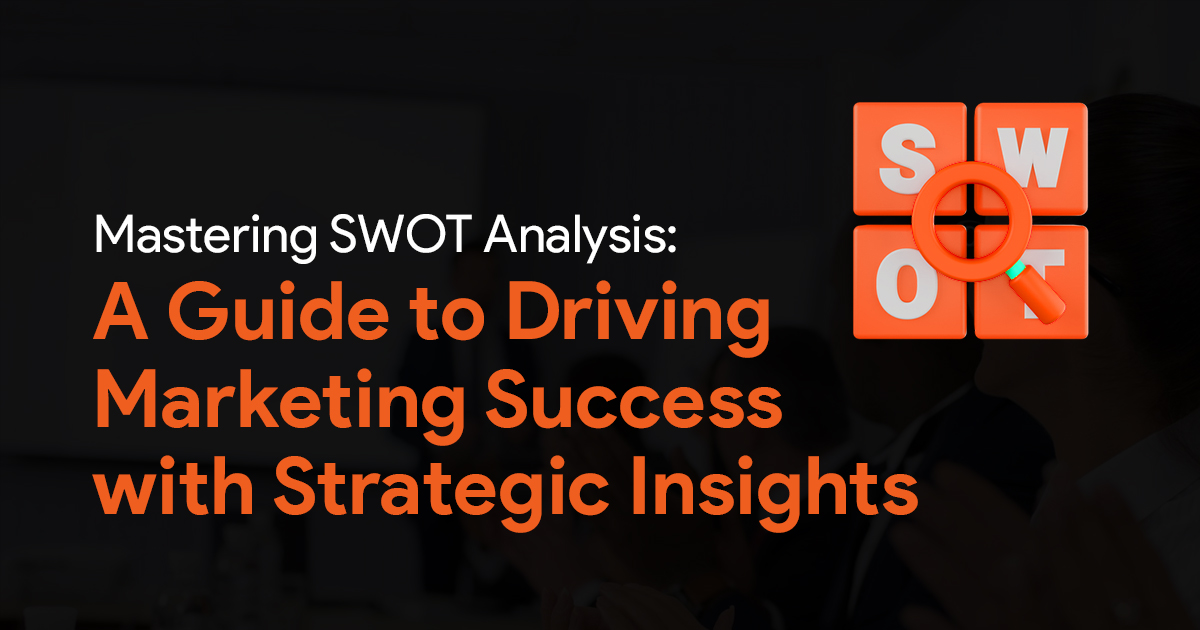Master SWOT Analysis for Marketing: A Guide to Driving Success with Strategic Insights

In the fast-paced realm of marketing, measuring the effectiveness of campaigns is paramount for staying ahead. Yet, many businesses fall into the trap of assessing performance solely based on post-campaign metrics. While these metrics give useful insights, they often miss the bigger picture and possible problems with marketing efforts. This is where a strategic SWOT analysis for marketing comes into play, offering a holistic view to inform smarter decisions and drive campaign success.
Understanding SWOT Analysis:
SWOT, standing for Strengths, Weaknesses, Opportunities, and Threats, offers a structured way to assess the factors that affect marketing efforts. Unlike traditional metrics, SWOT analysis for marketing delves deeper, offering a panoramic view of your marketing landscape.
Benefits of SWOT in Marketing:
SWOT analysis transcends the confines of conventional metrics, offering a myriad of benefits for marketers.
Comprehensive Insights: By considering both internal strengths and weaknesses alongside external opportunities and threats, SWOT analysis unveils a more nuanced understanding of your marketing landscape.
Timely Data: In a world where timely data is king, SWOT analysis equips marketers with the insights needed to adapt and respond swiftly to evolving market dynamics.
Strategic Focus: SWOT analysis directs attention to critical factors that impact marketing success, guiding strategic decision-making and resource allocation.
Long-term Planning: By identifying strengths to leverage, weaknesses to address, opportunities to seize, and threats to mitigate, SWOT analysis lays the groundwork for informed long-term planning.
Drawbacks of SWOT in Marketing
Despite its merits, SWOT analysis isn’t without limitations:
Honest Self-reflection: SWOT analysis hinges on honesty and introspection. Without a candid assessment of internal weaknesses, the insights derived may lack efficacy.
Complexity: Analysing complex factors that straddle the line between strengths and weaknesses can pose challenges, demanding a nuanced approach.
Data Overload: SWOT analysis for marketing has the potential to inundate marketers with copious amounts of data, necessitating careful interpretation and prioritization.
Performing a SWOT Analysis for Marketing Campaigns
To unleash the full potential of SWOT analysis, marketers must navigate the following steps:
Define Scope: Determine whether the analysis will encompass your entire marketing strategy or specific campaigns, clarifying the parameters upfront.
Assess Strengths: Identify what sets your marketing efforts apart, leveraging data to pinpoint areas of excellence.
Acknowledge Weaknesses: Confront areas of improvement head-on, drawing insights from customer feedback, reviews, and analytical data.
Uncover Opportunities: Explore avenues for growth and innovation, drawing inspiration from emerging trends and consumer preferences.
Mitigate Threats: Stay alert to industry changes and competitor moves to anticipate and avoid risks.
Utilizing SWOT Analysis Tools:
Harnessing the power of SWOT analysis is made more accessible with dedicated tools like SWOT analysis PowerPoint templates. These templates streamline the process, facilitating collaborative analysis and visual representation of insights.
Conclusion:
SWOT analysis serves as a beacon of clarity in the ever-changing landscape of marketing. By embracing this strategic framework, marketers can unlock invaluable insights, fortify their campaigns, and chart a course toward sustained success. Embrace SWOT analysis for marketing as your guiding compass, and watch as your marketing efforts reach new heights of effectiveness and efficiency.


